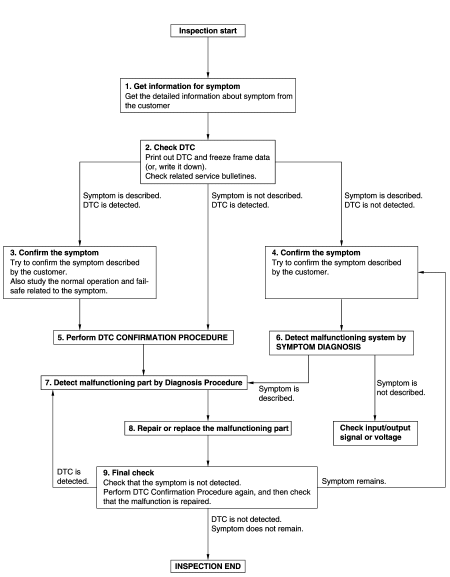Nissan Sentra Service Manual: Basic inspection
Diagnosis and repair work flow
Work flow
OVERALL SEQUENCE

Detailed flow
1.Get information for symptom
- Get detailed information from the customer about the symptom (the condition and the environment when the incident/malfunction occurs)
- Check operation condition of the function that is malfunctioning.
>> GO TO 2.
2.Check dtc
- Check dtc
- Perform the following procedure if dtc is detected.
- Record dtc and freeze frame data (print them out using consult.)
- Erase dtc.
- Study the relationship between the cause detected by dtc and the symptom described by the customer.
- Check related service bulletins for information.
Are any symptoms described and any dtc detected? Symptom is described, dtc is detected>>go to 3.
Symptom is described, dtc is not detected>>go to 4.
Symptom is not described, dtc is detected>>go to 5.
3.Confirm the symptom
Try to confirm the symptom described by the customer.
Also study the normal operation and fail-safe related to the symptom.
Verify relation between the symptom and the condition when the symptom is detected.
>> Go to 5.
4.Confirm the symptom
Try to confirm the symptom described by the customer.
Verify relation between the symptom and the condition when the symptom is detected.
>> Go to 6.
5.Perform dtc confirmation procedure
Perform dtc confirmation procedure for the detected dtc, and then check that dtc is detected again. At this time, always connect consult to the vehicle, and check self diagnostic results in real time.
If two or more dtcs are detected, refer to bcs-48, "dtc inspection priority chart" and determine trouble diagnosis order.
Note:
- Freeze frame data is useful if the dtc is not detected.
- Perform Component Function Check if DTC CONFIRMATION PROCEDURE is not
included on Service
Manual. This simplified check procedure is an effective alternative though
DTC cannot be detected during
this check.
If the result of Component Function Check is NG, it is the same as the detection of DTC by DTC CONFIRMATION PROCEDURE.
Is dtc detected? Yes >> go to 7.
No >> check according to gi-39, "intermittent incident".
6.Detect malfunctioning system by symptom diagnosis
Detect malfunctioning system according to symptom diagnosis based on the confirmed symptom in step 4, and determine the trouble diagnosis order based on possible causes and symptom.
Is the symptom described? Yes >> go to 7.
No >> monitor input data from related sensors or check voltage of related module terminals using consult
7.Detect malfunctioning part by diagnosis procedure
Inspect according to Diagnosis Procedure of the system.
Is malfunctioning part detected? YES >> GO TO 8.
NO >> Check according to GI-39, "Intermittent Incident".
8.Repair or replace the malfunctioning part
- Repair or replace the malfunctioning part.
- Reconnect parts or connectors disconnected during Diagnosis Procedure again after repair and replacement.
- Check dtc. If dtc is detected, erase it.
>> GO TO 9.
9.Final check
When DTC is detected in step 2, perform DTC CONFIRMATION PROCEDURE again, and then check that the malfunction is repaired securely.
When symptom is described by the customer, refer to confirmed symptom in step 3 or 4, and check that the symptom is not detected.
Is DTC detected and does symptom remain? YES-1 >> DTC is detected: GO TO 7.
YES-2 >> Symptom remains: GO TO 4.
NO >> Before returning the vehicle to the customer, always erase DTC.
 Wiring diagram
Wiring diagram
Power door lock system
Wiring diagram
Intelligent key system
Wiring diagram
Trunk lid opener
Wiring diagram ...
 DTC/circuit diagnosis
DTC/circuit diagnosis
U1000 CAN COMM CIRCUIT
Description
Refer to lan-7, "can communication system : system description".
Dtc logic
Dtc detection logic
Note:
U1000 can be set if a module harness was disconn ...
Other materials:
ABS Warning lamp
Component Function Check
1.CHECK ABS WARNING LAMP FUNCTION
Check that ABS warning lamp in combination meter turns ON for
approximately 2 seconds after ignition switch
is turned ON.
Is the inspection result normal?
YES >> Inspection End.
NO >> Proceed to diagnosis procedure. ...
Preparation
Special Service Tools
The actual shapes of Kent-Moore tools may differ from those of special
service tools illustrated here.
*: The O-ring as a unit part is set as a SST.
Commercial Service Tools
...
Removal and installation
A/C SWITCH ASSEMBLY
Removal and Installation
REMOVAL
Remove the CVT shift selector finisher (CVT: RE0F11A). Refer to TM-253,
"Removal and Installation".
Remove the MT shift selector finisher (6MT: RS6F94R). Refer to TM-22,
"Removal and Installation".
Remove the A/ ...
